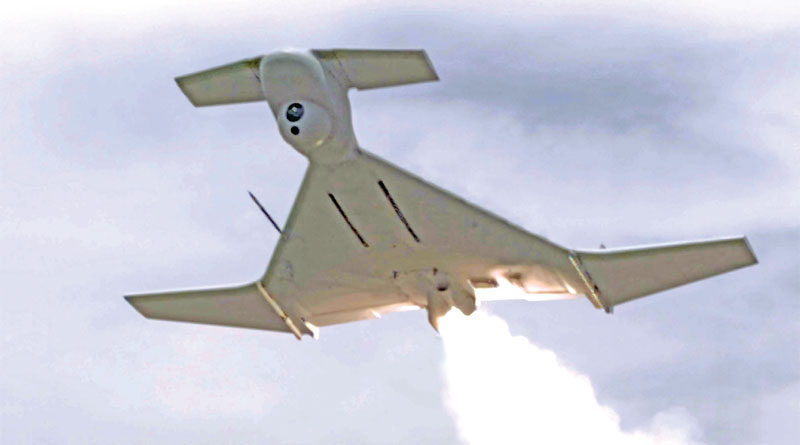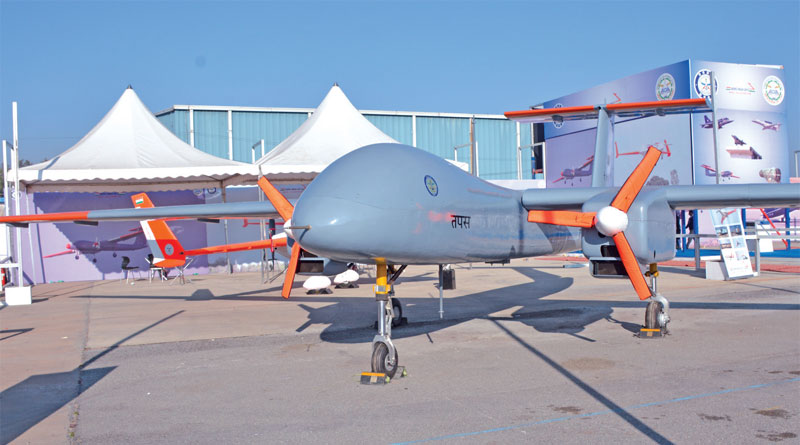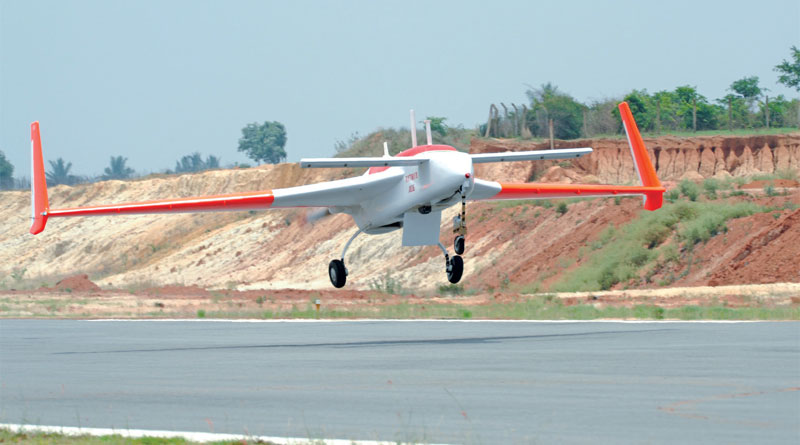The government needs to prioritise IAF’s requirement for armed and unarmed drones
 Gp Capt. A.K. Sachdev (retd)
Gp Capt. A.K. Sachdev (retd)
Unmanned aerial platforms are almost as old as controlled, heavier-than-air flight; the term ‘drone’—used to describe remotely (or autonomously) controlled, unmanned aircraft—was first used to describe small target aircraft employed for practice firing by ship-mounted guns in the 1920s.
A century later, drones have come a long way. Every role that an aircraft, fixed wing or rotary, can perform is now in the realm of drones. All the offensive roles have been performed by them including carriage of bombs, missiles, guns, rockets, air to air missiles and even more significantly, suicide strike missions which manned aircraft could never be assigned. All C4ISR roles have been assigned to them in their various forms. Medical and casualty evacuation has been carried out by them. Re-supply and logistic support have been done by them extensively.
The loyal wingman concept with unmanned wing support and manned aircraft protection is already proven and unmanned wingmen are under development and manufacture. Even air to air refuelling has been carried out by an unmanned tanker. Artificial Intelligence (AI) is increasingly living up to its promise of empowering unmanned flight and adding new nuances to drones, helping them to assertively usurp manned aircraft roles. In this backdrop, let us see if there is a need to bolster the unmanned prowess of the Indian Air Force (IAF).

IAF’s Unmanned Muscle
In the 1980s, the IAF had used the Chukar drones manufactured by the US but it did not acquire many drones. Just as the drone attacks on Jammu airfield in June this year sparked off a flurry of activity and thought on defence against drones, our experience in Kargil (mid-1999) had also ignited renewed interest in drones. Use of rotary and fixed wing aircraft during Kargil was constrained due to the terrain; this reality and the inhuman treatment meted out to pilots downed over Pakistani territory were convincing factors in favour of drones with their advantages of slow speeds, high manoeuvrability and absence of onboard pilots.
The IAF had acquired its first drone—Israel Aerospace Industries’s (IAI) Searcher 1 and formed its first Unmanned Aerial Vehicle (UAV) squadron (No 34 Squadron) in November 2000, at Bhatinda. In December 2003, the UAV squadrons were re-numbered in the 3000 series. Israel, ever ready to enter into defence industrial relations with Indian government and Indian business entities, offered the Searcher I and later Searcher II. Reportedly, Searcher IIs are equipped with the standard day/ night surveillance turrets. According to open sources, there are five squadrons and a Tech Flight but the UAV holding of the IAF is a closely guarded secret and can only be surmised to be around 100 as open sources give the total number of UAVs held by the Indian military to be around 200.
IAI’s Heron 1, a Medium Altitude Long Endurance (MALE) UAV, was inducted by the IAF in 2003. It was designed to carry out strategic reconnaissance and surveillance and Israel offered it to India more for the validation and trial phase of the UAV. India was thus the first user of Heron 1. The Israeli Air Force and Turkish Defence Forces followed and deployed it for high altitude land surveillance and maritime patrol missions.
Indian Heron 1s are reportedly configured with an Elta Systems radar and a stabilised Tamam surveillance and targeting turret. The Heron 1 has demonstrated flight operations of up to 52 hours duration at up to 35,000 ft but typically flies 40 hours at an altitude of 30,000 ft with a range of 3,000km and a 250kg payload which could be electro-optical and thermal surveillance equipment, SAR radars for ground surveillance, maritime patrol radars and sensors, signals and other intelligence collection antennas and equipment, laser designators, and even radio relays.
The IAF was expected to replace all its Searcher I and II UAVs with the Heron 1, but that did not happen and the Searcher II UAVs continue to be in service. Initially, 12 Heron 1s were procured and in 2005, another 50 were reportedly ordered.
The IAF had been seeking Heron TP UAV since 2012. Its procurement was approved in 2015, with reports emerging in mid-2016 that entry into service with the IAF was imminent, possibly triggered by Pakistan’s use of its indigenous Burraq in a successful counter terrorist strike in 2015, in the Shawal Valley which killed three terrorists.
However, the acquisition process remained in animated suspension until September this year when India finalised a deal for four Heron-TP variant for surveillance and reconnaissance missions. Heron TP is larger than Heron 1, with a bigger 1,200hp Pratt & Whitney PT6A turbo-prop to power it. The typical mission payload rises to 1,000kg, which can be carried to around 45,000 feet and the UAV has a maximum flight time of over 36 hours in favourable conditions. Project Cheetah, first initiated by IAF in 2013, is a Rs 5,000 crore long pending Heron upgradation programme which is expected to arm the Heron 1 and Heron TP with laser guided bombs, air to ground, and air-launched anti-tank guided missiles.

In 2009, the IAF purchased 10 Harops from IAI under a USD100-million contract. Harop is a Loitering Munition (LM) system developed in Israel by the MBT missiles division of IAI. This Unmanned Combat Aerial Vehicle (UCAV) is also known as the Harpy-2 Loitering Munitions missile. The drone loiters over the battlefield and attacks targets by self-destructing into them. The Harop UCAV has been developed from the Harpy UAV, also developed by the IAI. This combat drone was unveiled in India at Aero India 2009 air show.
During Modi’s visit to the US in September this year, one of the agenda points reported was the purchase of 30 MQ-9B SkyGuardian/ SeaGuardian drones. The SeaGuardian is the maritime version of MQ-9B SkyGuardian, 10 of which would be procured for the navy, while the Army and the IAF would get 10 each of the MQ-9B version. Both are High Altitude Long Endurance (HALE) Remotely Piloted Vehicles (RPA) variety of surveillance system capable of 27 hours vigil at 50,000 feet altitude. It is common (but not accurate) to see this drone being referred to as Predator.
Actually the MQ-1 was the Predator while the MQ-9A was designated Reaper by US Air Force (USAF), but more widely referred to as Predator B. The MQ-9B SkyGuardian/ SeaGuardian is a variant of Predator B. Addition of 10 MQ-9 SkyGuardians to the IAF’s inventory would be a significant attainment but is taking time due to the high cost and the complicated procedure for procurement.

Indigenous Options for IAF
Indigenous development of UAVs started in the 1990s with the Aeronautical Development Establishment (ADE) being directed to produce India’s first Nishant UAV based on the Indian Army’s requirement for an intelligence gathering platform over enemy territory. The Nishant first flew in 1995. However, four Nishants were lost in accidents and the army lost interest in the craft.
Starting 2003, DRDO then developed a MALE UAV Rustom-I, the design based on Rutan Long-EZ Homebuilt aircraft developed by US-based Rutan Aircraft Factory. The Rustom-1 was supposed to be a technology demonstrator platform for more advanced and more capable UAVs. The Rustom-I had its first flight in 2009, but the project did not evince much interest with the IAF due to the slow pace of development and an inadequate sensor package. The Rustom-I is unlikely to ever be a full-scale production UAV.
Tactical Advanced Platform for Aerial Surveillance or TAPAS (BH-201), earlier known as Rustom-II, made its first flight in 2016, but had major technical problems. It is touted as India’s first indigenous UCAV with a range of 1,000 km and a payload of 350 kg but all indications are that it will take a long time to be operationally available to the IAF, especially as the project appears to be under Hindustan Aeronautics Limited (HAL) whose internal inefficiencies are notorious. In 2014, the DRDO had unveiled Panchi, a wheeled version of the Nishant, but its future is as yet uncertain.
Some smaller UAV projects initiated by the DRDO which have had some success are Pilot-less Target Drones such as Abhyas, Netra and Lakshay (which the IAF operates in small numbers) but there still has not been a significant, successful major UAV programme. India also has initiated studies and research to develop an autonomous UCAV called ‘Aura’ which the DRDO describes as long-range, self-defending, high-speed reconnaissance UAV with weapon carrying capabilities. ‘Aura’ is expected to have stealth properties to make it undetectable by radar and thus suitable for cross border strikes.
In short, the DRDO has had some success with small UAVs but projects worthy of the IAF’s needs and wants appear to be very distant in the future. Slow rates of progress and minimal levels of technology (lagging far behind the sharply rising curve of UAV development worldwide) have meant that the IAF is dependent on imports which are exorbitantly priced. Notwithstanding the huge push for ‘Atmanirbhar’ by the present government, the fact that the fourth largest air force in the world is constrained to import UAVs is embarrassing.
ADE, HAL and Bharat Electronics Limited (BEL) are the main public sector entities that have been working in collaboration with IAI, ideaForge and Edall Systems to develop and produce UAVs. Regrettably, the slow speed at which ‘Make In India’ is making inroads into defence and aerospace sectors, has meant that inefficient and low productivity public sector enterprises have retained their hold and shackled the two sectors.
Recent forays into the UAV domain by private Indian entities appear to be encouraging signs, the most significant perhaps being the setting up of AdaniElbit UAV manufacturing facility in Hyderabad. This is a JV between Adani Defence and Aerospace, part of Adani group and Israel-based Elbit Systems. It is the first private UAV manufacturing unit in India and the first one outside Israel to manufacture an Israeli UAV, namely Hermes 900 MALE UAV and later, the Hermes 450.

Adani Defence and Aerospace has also involved in the project Comprotech, AutoTEC, Alpha Tocol and Alpha Design Technologies in which Adani Group has picked up a substantial stake. Reliance Defence and Tata Advanced Systems Limited (TASL) are also entering the UAV arena and the future looks promising. However, it will be at least a decade before tangible result in terms of UAVs of real operational use to the IAF become available from the private sector.
The US and Israel, leading edge manufacturers of unmanned systems should be persuaded to partner with Indian private sector entities for development of indigenous unmanned systems. Of course, there would be resistance from the well entrenched (but grossly incompetent) public sector and that is where the government has to show resolve if India has to move forward in this arena. Private participation is the first and foremost option that holds the promise of meeting Indian military needs of unmanned systems. Simultaneously, the public sector’s modest achievements so far can be built upon to advance towards bigger and more lethal systems.
Concluding Remarks
The foregoing shows that IAF’s drone holding is far from adequate to meet its needs and wants and that indigenous development is unlikely to proffer something useful to the IAF for many years to come. Thus, import from Israel and the US appears to be the way forward.
Undoubtedly, there is a need for indigenous industry to collaborate with leaders in drone technology. India and US have recently signed an agreement to jointly develop Air-Launched Unmanned Aerial Vehicle (ALUAV)—drones that can be launched from an aircraft. This is in anticipation of teaming up manned and unmanned aircraft for missions. However, as the Indian entity involved is ADE, hopes of spectacular achievements by the project ought to be tempered with prudence.
The Heron TP has been criticised as not been designed to operate in hostile airspace and possessing limited utility and high vulnerability if sent on a mission across the borders of India with either China or Pakistan. This is on account of its slow, turbo-prop speed and lack of stealth features. One hopes that the small number (four) on order is indicative that it may be just a stepping stone to a more capable, jet engine powered UAV with comparatively higher survivability and stealth features.
Since 2000, the use of UAVs by the IAF has had a major limitation as it has been largely confined to Line of Sight (LoS) data linkage, minimally supported by ground-based, relay link stations supplied by IAI. This limitation did not exist for National Technical Research Organisation (NTRO) which had satellite communication equipment to support its operations. With the launch of the IAF’s dedicated communications GSAT-7A satellite in December 2018, UAV deployment and productivity have been enhanced significantly as has been the IAF’s capability to contribute to network-centric warfare. The satellite costs only USD85 million; but the value addition to IAF’s UAV utilisation is immeasurable as it will greatly improve the capability to receive real time data from UAVs.

The IAF has been mooting a separate, role-specific cadre for its UAV force so that professionals are recruited for this niche specialty, much like pilots for the other streams. The proposal was initiated by its Training Command in 2012. However, the push for theatrisation is likely to fade away the proposal in favour of a unified UAV force and creating another silo within the IAF may not be acceptable.
The Jammu drone attack has also served to underscore the need for the IAF (and indeed the Indian military) to have anti-drone capabilities in ever increasing measures. The IAF has already signed up with Zen Technologies for such systems even as DRDO claims to be developing the capability.
The steadily increasing role that drones are playing in warfare of all hues is self evident and there is a need for importance to be given to arming the IAF with UAVs/ UCAVs in larger numbers and with more potency. However, given the fact that the IAF is wrestling with its combat aircraft strength down to 30 against a sanctioned strength of 42 squadrons, and the pathetically inadequate capital budgetary allocation to the IAF in the last budget, the prospects of a substantial boost to the IAF’s UAV capability appear desolately bleak.
Possibly, the stratagem to counter the low budgetary allocation is to acquire much-needed drones through leasing, now permitted by the Defence Acquisition Procedure 2020. Meanwhile, the need to bolster the IAF’s unmanned segment remains a critical one.

